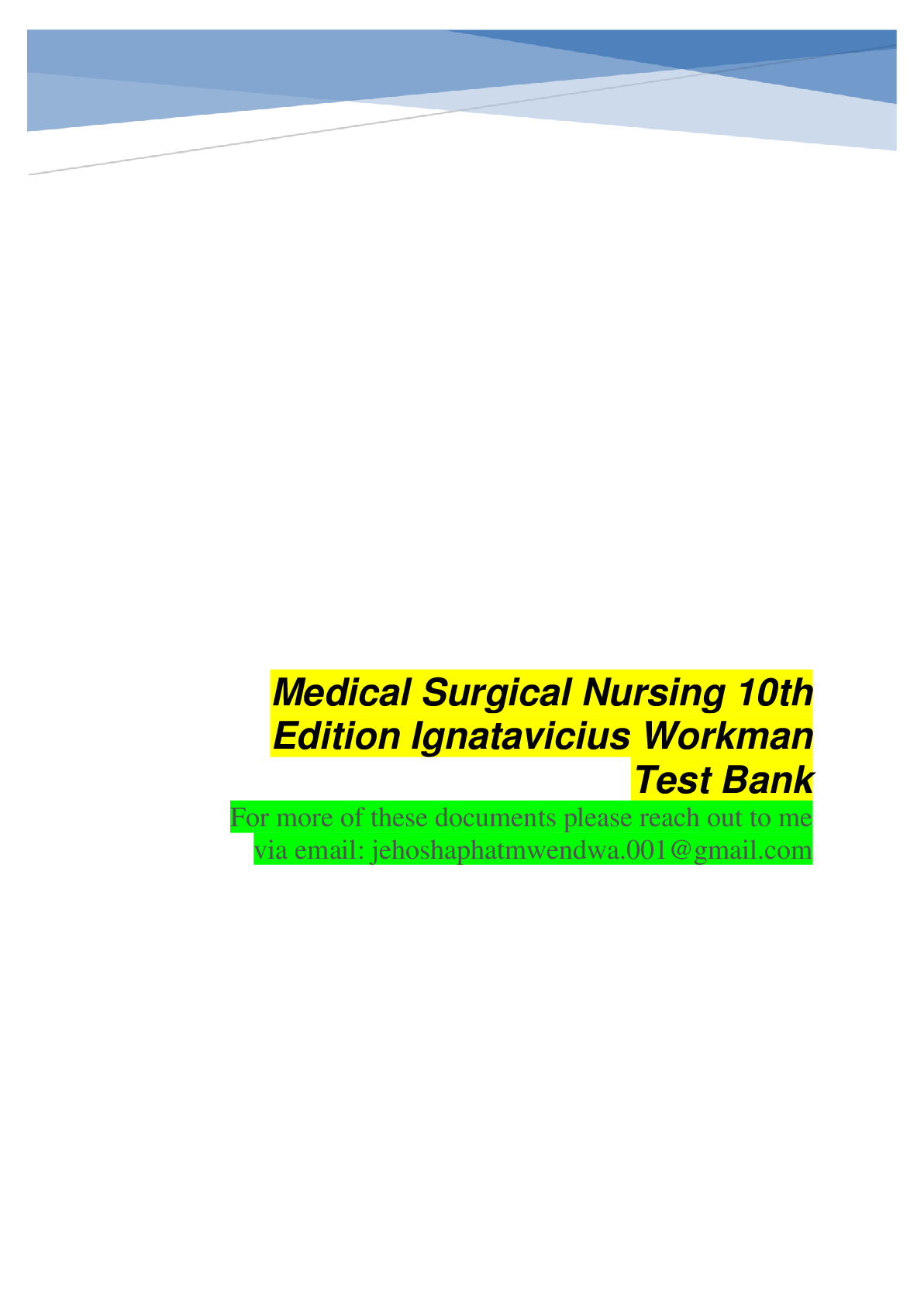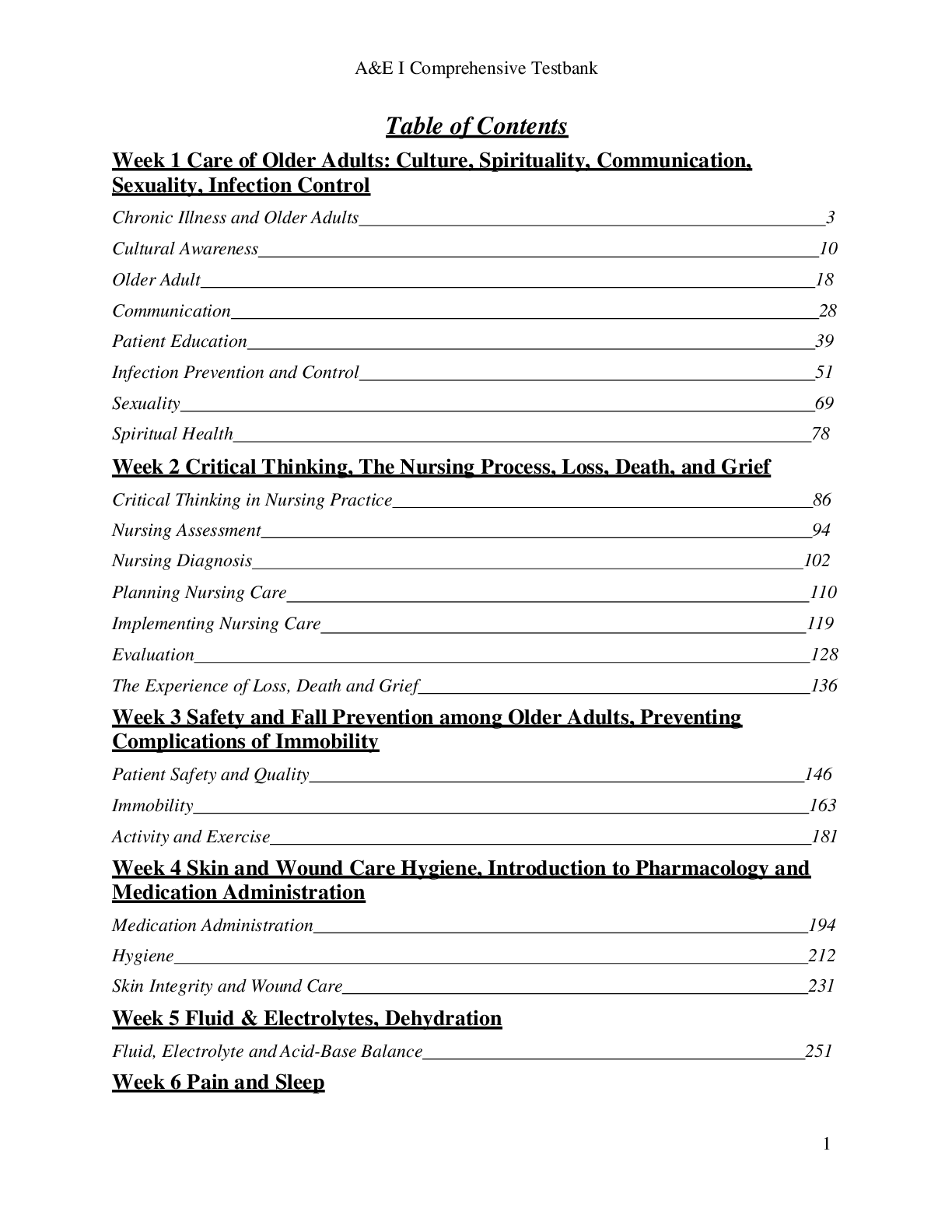Health Care > EXAM > Introduction To Medical Surgical Nursing 6th Edition by Linton - Test Bank (All)
Introduction To Medical Surgical Nursing 6th Edition by Linton - Test Bank
Document Content and Description Below
Introduction To Medical Surgical Nursing, 6th Edition by Linton – Test Bank Description Chapter 03: Legal and Ethical Considerations Linton: Introduction to Medical-Surgical Nursing, 6th Edition... MULTIPLE CHOICE 1. A good friend of a licensed practical/vocational nurse (LPN/LVN) confides that she is in a serious romantic relationship with a man the LPN/LVN had as a patient when he was diagnosed with the human immunodeficiency virus (HIV). The policies of the Health Insurance Portability and Accountability Act (HIPAA) prevent the nurse from warning her friend. What is this situation considered? a. Moral dilemma b. Moral uncertainty c. Moral distress d. Moral outrage ANS: C Moral distress occurs when a nurse feels powerless because moral beliefs cannot be honored because of institutional or other barriers. DIF: Cognitive Level: Comprehension REF: p. 32 OBJ: 1 TOP: Moral Distress KEY: Nursing Process Step: N/A MSC: NCLEX: Safe, Effective Care Environment: Coordinated Care 2. A nurse reminds a resident in a long-term care facility that he has autonomy in many aspects of his institutionalization. What is an example of autonomy? a. Selection of medication times b. Availability of his own small electrical appliances c. Smoking in the privacy of his own room d. Application of advance directives ANS: D The application of advance directives is an autonomous decision. Agency protocols relative to medication times, access to private electrical devices, and smoking are rarely waived; these policies are not in the control of the resident. DIF: Cognitive Level: Comprehension REF: p. 32 OBJ: 2 TOP: Autonomy KEY: Nursing Process Step: Implementation MSC: NCLEX: Psychosocial Integrity: Coping and Adaptation 3. How might an LPN/LVN exhibit beneficence? a. Remove defective equipment from the patient’s room. b. Willingly work extra shifts during a staff shortage. c. Adhere to agency policy. d. Join the National Association for Practical Nurse Education and Service (NAPNES) and attend ANS: A Beneficence means promoting good and reducing harm. Removing defective equipment demonstrates that the LPN/LVN is reducing possible harm to the patient. Working extra shifts, adhering to policy, and joining NAPNES are personal values, not beneficence. DIF: Cognitive Level: Comprehension REF: p. 32 OBJ: 2 TOP: Beneficence KEY: Nursing Process Step: N/A MSC: NCLEX: N/A 4. An LPN/LVN is educating a group of nursing students regarding values demonstrated in their nursing practice. Where will the LPN/LVN indicate the base of these values is derived? a. Nursing school education b. Family influence c. Peer relationships d. Agency policies ANS: B The family shapes values that are demonstrated in later life. These values may be enhanced or challenged by life experiences, but the base is forged in the family. DIF: Cognitive Level: Comprehension REF: p. 32 OBJ: 3 TOP: Values KEY: Nursing Process Step: N/A MSC: NCLEX: N/A 5. One obstetric nurse remarks, “I don’t see how these young single women can keep on having babies without being married. Everyone knows a child needs a father.” What is this nurse exhibiting? a. Ethnocentrism b. Moral uncertainty c. Values clarification d. Professional concern ANS: A Ethnocentricity is the belief that one’s own culture and values are superior to those of another. Such statements are based on values clarification and, perhaps, on moral outrage. DIF: Cognitive Level: Comprehension REF: p. 33 OBJ: 5 TOP: Ethnocentrism/Values Clarification KEY: Nursing Process Step: N/A MSC: NCLEX: N/A 6. A nursing student asks the instructor to define the philosophic stand of utilitarianism. What example should the instructor provide? a. An army officer sacrifices six paratroopers to save 100 prisoners of war. b. A priest burns down his church because it was defiled by Satanists. c. A mother jumps off a cliff with her baby to avoid being captured by Indians. d. A soldier murders captured enemies to prevent their divulging military secrets. ANS: A The sacrifice of six to save 100 is an example of the greater good. The other options are based on the philosophy of deontology. DIF: Cognitive Level: Comprehension REF: p. 33 OBJ: 6 TOP: Utilitarianism KEY: Nursing Process Step: N/A MSC: NCLEX: N/A 7. An LPN/LVN explains to a patient that the hospital has an institutional ethics committee. What is the main function of this committee? a. Preside over policy implementation. b. Revoke the license of someone who violates the law. c. Solve personnel disputes. d. Ensure that hiring adheres to ethnic equality. ANS: A The main job of the institutional ethics committee is to preside over the implementation of agency policy. DIF: Cognitive Level: Comprehension REF: p. 34 OBJ: 8 TOP: Institutional Ethics Committee KEY: Nursing Process Step: Implementation MSC: NCLEX: Safe, Effective Care Environment: Coordinated Care 8. An LPN/LVN charts that “the patient is drunk and acting in a crazy manner.” The team leader cautions the LPN/LVN that this documentation is not appropriate. What charges of commission of the intentional tort is this an example of? a. Assault b. Wrongful publication c. Defamation of character d. Invasion of privacy ANS: C Charting or saying unsupported defamatory statements can lead to tort litigation. DIF: Cognitive Level: Comprehension REF: p. 38 OBJ: 2 TOP: Torts KEY: Nursing Process Step: N/A MSC: NCLEX: Safe, Effective Care Environment: Coordinated Care 9. When an LPN/LVN assists an older woman to stand after a fall in a shopping mall parking lot, the woman twists and sprains her ankle. What protects the LPN/LVN from litigation or an unintentional tort? a. Hospital malpractice insurance b. Good faith agreement c. Good Samaritan law d. Personal professional insurance ANS: C The Good Samaritan law protects individuals who assist at an accident scene if they act in good faith. Professional insurance is not in effect because the actions were not performed while the LPN/LVN was on duty. DIF: Cognitive Level: Comprehension REF: p. 39 OBJ: 2 TOP: Torts KEY: Nursing Process Step: N/A MSC: NCLEX: N/A 10. An LPN/LVN trimmed the toenails of a patient with diabetes too short, which results in a toe amputation from infections. What is the LPN/LVN guilty of? a. Unintentional tort b. Intentional tort c. Negligence d. Malpractice ANS: D Malpractice occurs when an unintentional tort causes an injury to a patient. DIF: Cognitive Level: Comprehension REF: p. 39 OBJ: 2 TOP: Malpractice KEY: Nursing Process Step: N/A MSC: NCLEX: N/A 11. What must an LPN/LVN acquiring a signature on a surgical informed consent document ensure? a. The patient is not sedated. b. The physician is present. c. The family member is a witness. d. The signature is in ink. ANS: A Before surgery, the consent form must be signed before any preoperative sedation is administered. A sedated person cannot give a valid consent. DIF: Cognitive Level: Application REF: p. 40 OBJ: 9 TOP: Informed Consent KEY: Nursing Process Step: N/A MSC: NCLEX: Safe, Effective Care Environment: Coordinated Care 12. A physician has written an order for Synthroid, 137 mg. The LPN/LVN is aware that the drug is measured in micrograms. What action should the nurse implement? a. Transcribe the order as if it were written in micrograms. b. Notify the nursing supervisor. c. Transcribe the order as written. d. Call the prescribing physician. ANS: D The LPN/LVN may call the physician to clarify the order but may not alter the written order in any way. The order for the correct dose will be written as a new order. DIF: Cognitive Level: Application REF: p. 40 OBJ: 12 TOP: Doctor’s Orders KEY: Nursing Process Step: N/A MSC: NCLEX: Safe, Effective Care Environment: Coordinated Care 13. A physician has written an order for morphine sulfate, 100 mg. The LPN/LVN inquires if he meant to write 10 mg. The physician confirms that he meant 100 mg. What action should the LPN/LVN implement? a. Call a member of the hospital administration. b. Refuse to transcribe the order. c. Call the pharmacist. d. Notify the nursing supervisor. ANS: D In the event of a physician’s refusal to clarify a questionable order, the LPN/LVN should notify the nursing supervisor to intervene. DIF: Cognitive Level: Application REF: p. 40 OBJ: 12 TOP: Doctor’s Orders KEY: Nursing Process Step: N/A MSC: NCLEX: Safe, Effective Care Environment: Coordinated Care MULTIPLE RESPONSE 14. On what are health care ethics based? (Select all that apply.) a. Autonomy b. Fidelity c. Professionalism d. Justice e. Nonmaleficence ANS: A, B, D, E Health care ethics are based on autonomy, fidelity, beneficence, justice, and nonmaleficence DIF: Cognitive Level: Knowledge REF: p. 32 OBJ: 2 TOP: Health Care Ethics KEY: Nursing Process Step: Implementation MSC: NCLEX: Safe, Effective Care Environment: Coordinated Care 15. How does values clarification support nursing practice? (Select all that apply.) a. Guides decision making b. Gives insight to patients c. Enhances peer relationships d. Helps understand him or herself e. Gains the confidence of supervisors ANS: A, B, D Values clarification gives a person a foundation for moral decisions and insight into self and others. DIF: Cognitive Level: Comprehension REF: p. 33 OBJ: 4 TOP: Values Clarification KEY: Nursing Process Step: N/A MSC: NCLEX: N/A 16. An LPN/LVN arrives on duty at 0700 and is faced with the ethical dilemma of inadequate staffing for the day shift. How should the LPN/LVN invoke a “safe harbor”? (Select all that apply.) a. Immediately file a written protest with administration. b. Leave duty. c. Refuse the assignment. d. Call hospital administration. e. Suggest that the nursing assistants (NAs) file a written protest. ANS: A, E Filing a written protest relative to short staffing provides the “safe harbor” for the LPN/LVN and protects his or her license. Nonacceptance of the assignment or leaving duty is considered abandonment. Suggesting that the NA file a similar protest is an effective action. DIF: Cognitive Level: Application REF: p. 40 OBJ: N/A TOP: Inadequate Staffing KEY: Nursing Process Step: N/A MSC: NCLEX: N/A COMPLETION 17. The values that direct human behavior and are concerned with defining right from wrong are known as . ANS: ethics An individual’s ability to define right from wrong is based on a value system called ethics. DIF: Cognitive Level: Knowledge REF: p. 31 OBJ: 1 TOP: Ethics KEY: Nursing Process Step: N/A MSC: NCLEX: Psychosocial Integrity OTHER 18. Prioritize the steps in solving an ethical dilemma. (Separate the letters with a comma and space: A, B, C, D.) 19. Evaluate the outcome. 20. Plan an approach. 21. Visualize the consequences. 22. Take action. 23. Identify the problem. ANS: E, B, C, D, A To solve an ethical dilemma, one must clearly identify the problem, plan an approach, visualize the consequences, take action, and evaluate the outcome. DIF: Cognitive Level: Comprehension REF: p. 34 OBJ: 7 TOP: Solving an Ethical Dilemma KEY: Nursing Process Step: N/A MSC: NCLEX: N/A [Show More]
Last updated: 1 year ago
Preview 1 out of 13 pages
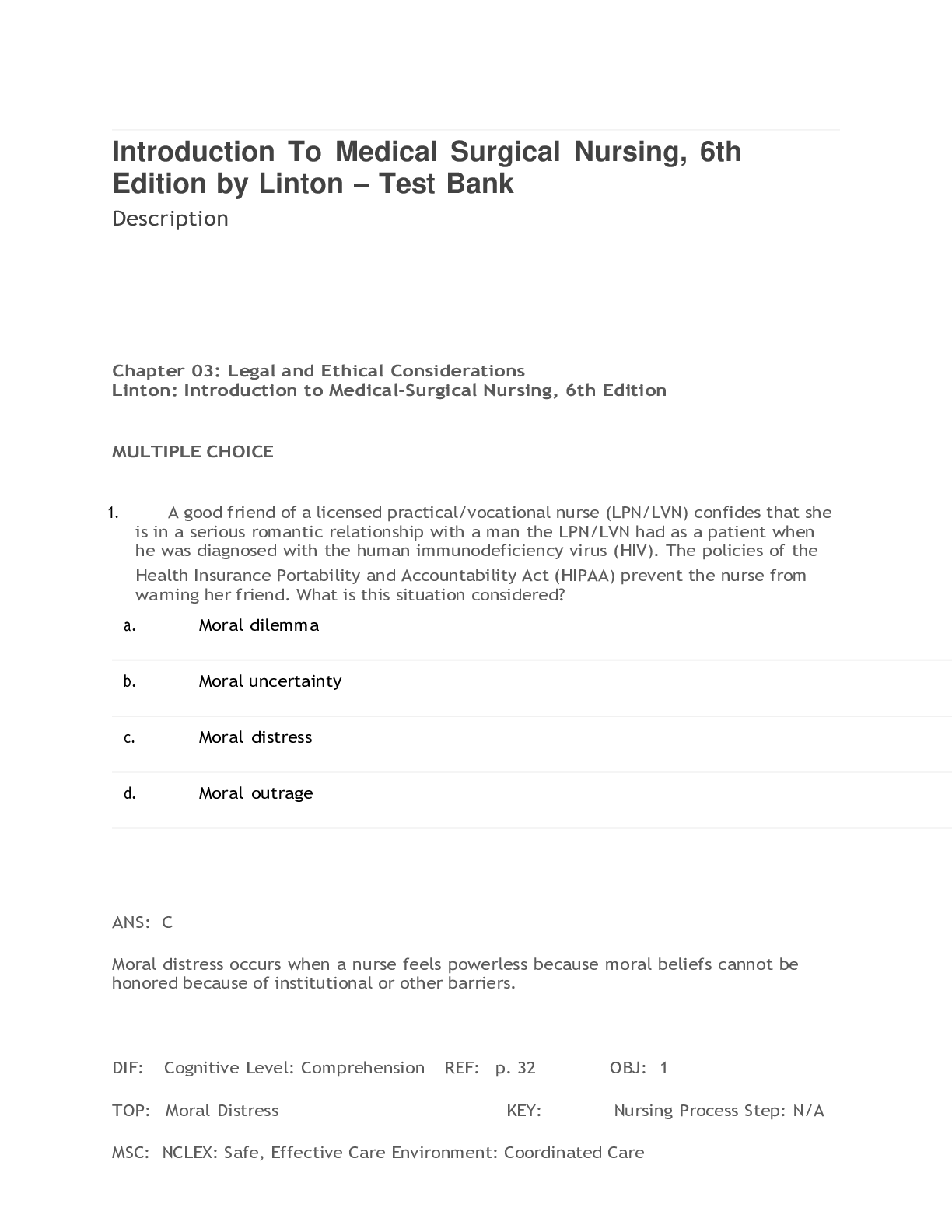
Reviews( 0 )
Document information
Connected school, study & course
About the document
Uploaded On
Oct 03, 2022
Number of pages
13
Written in
Additional information
This document has been written for:
Uploaded
Oct 03, 2022
Downloads
0
Views
39


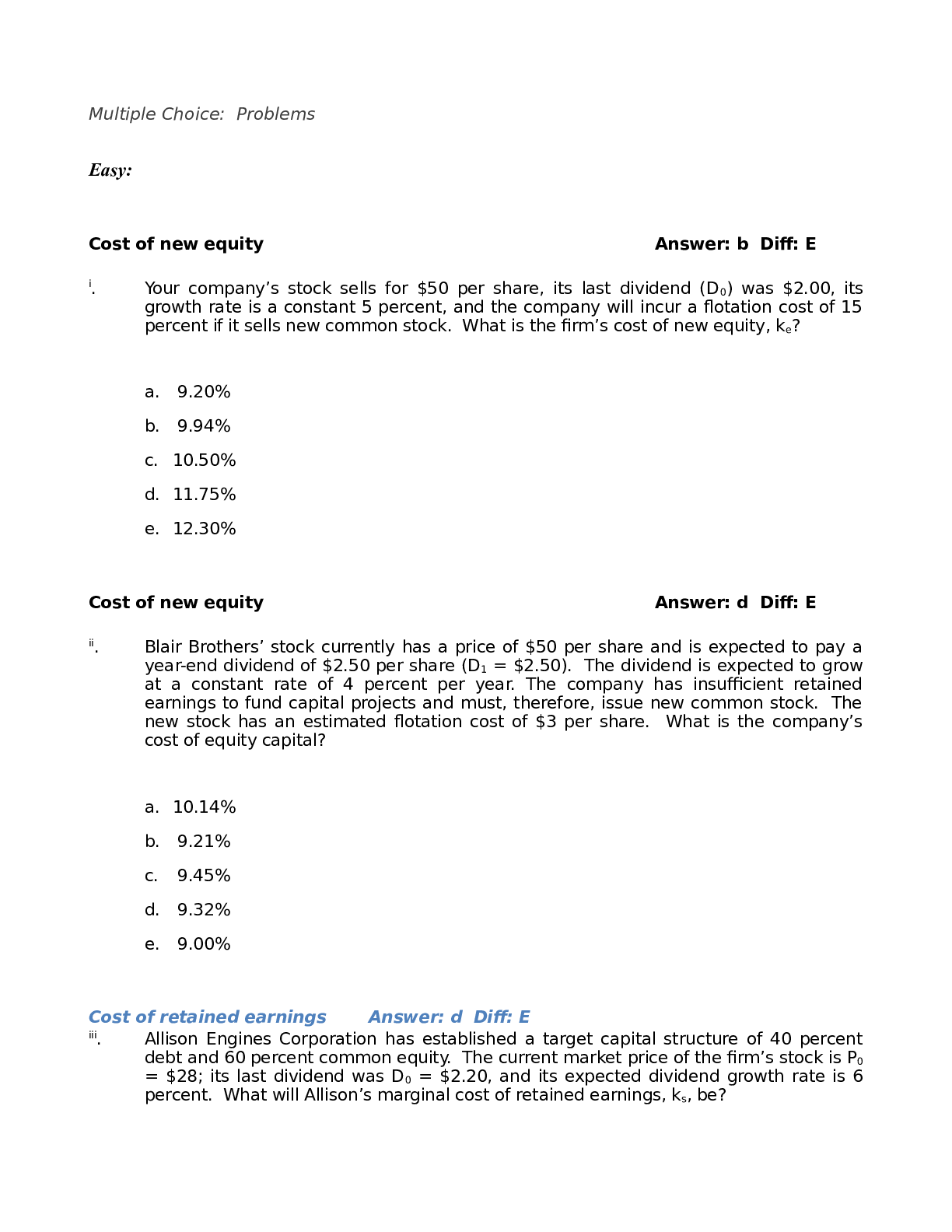
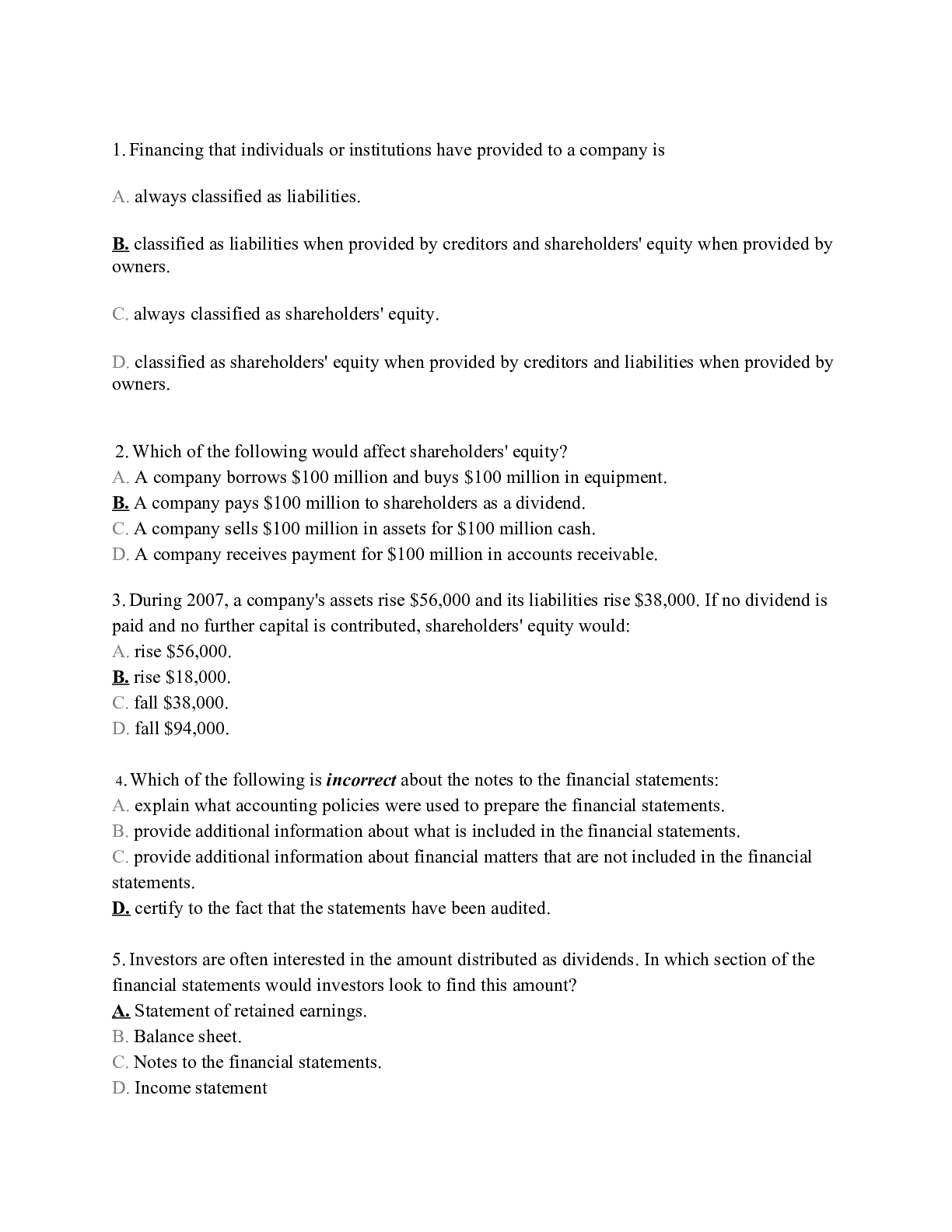
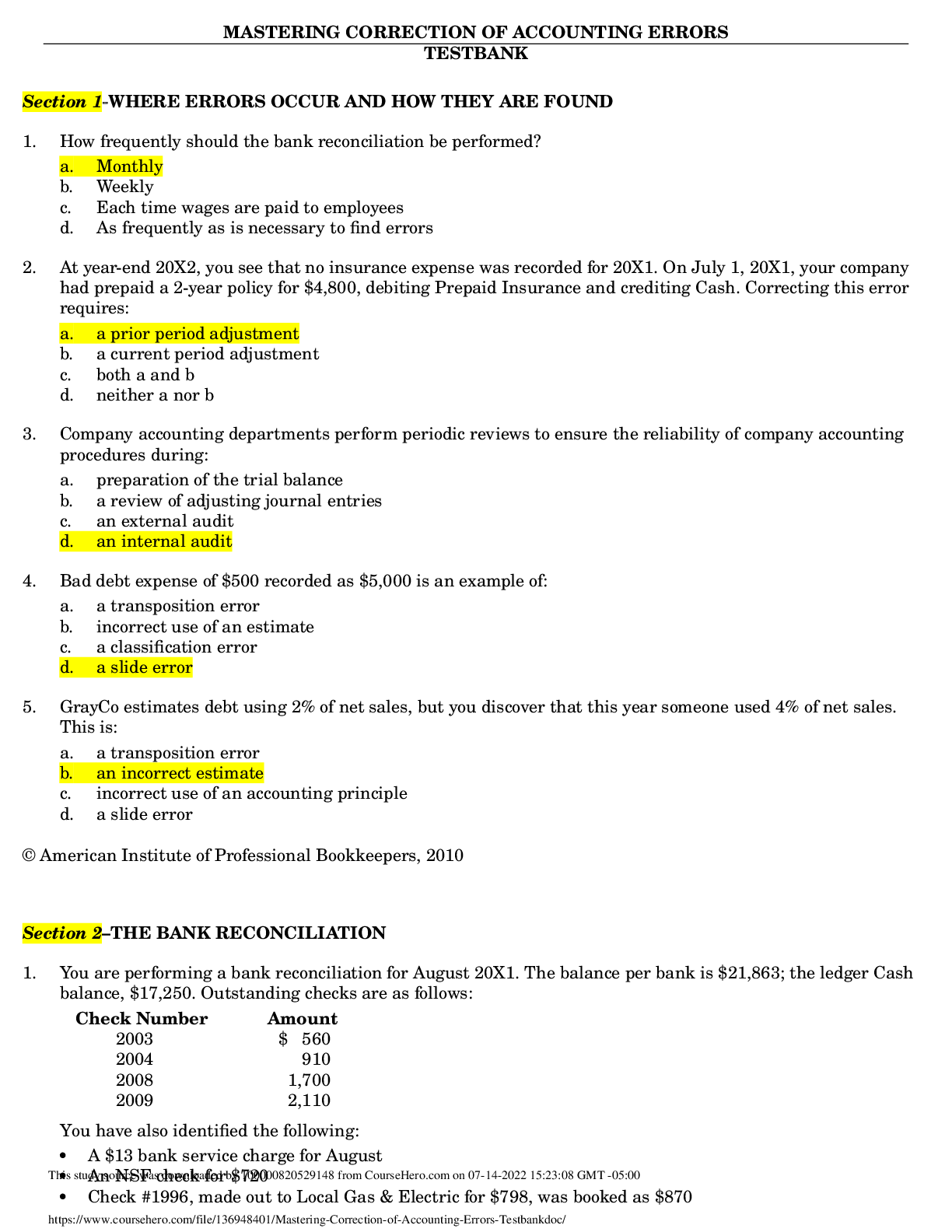
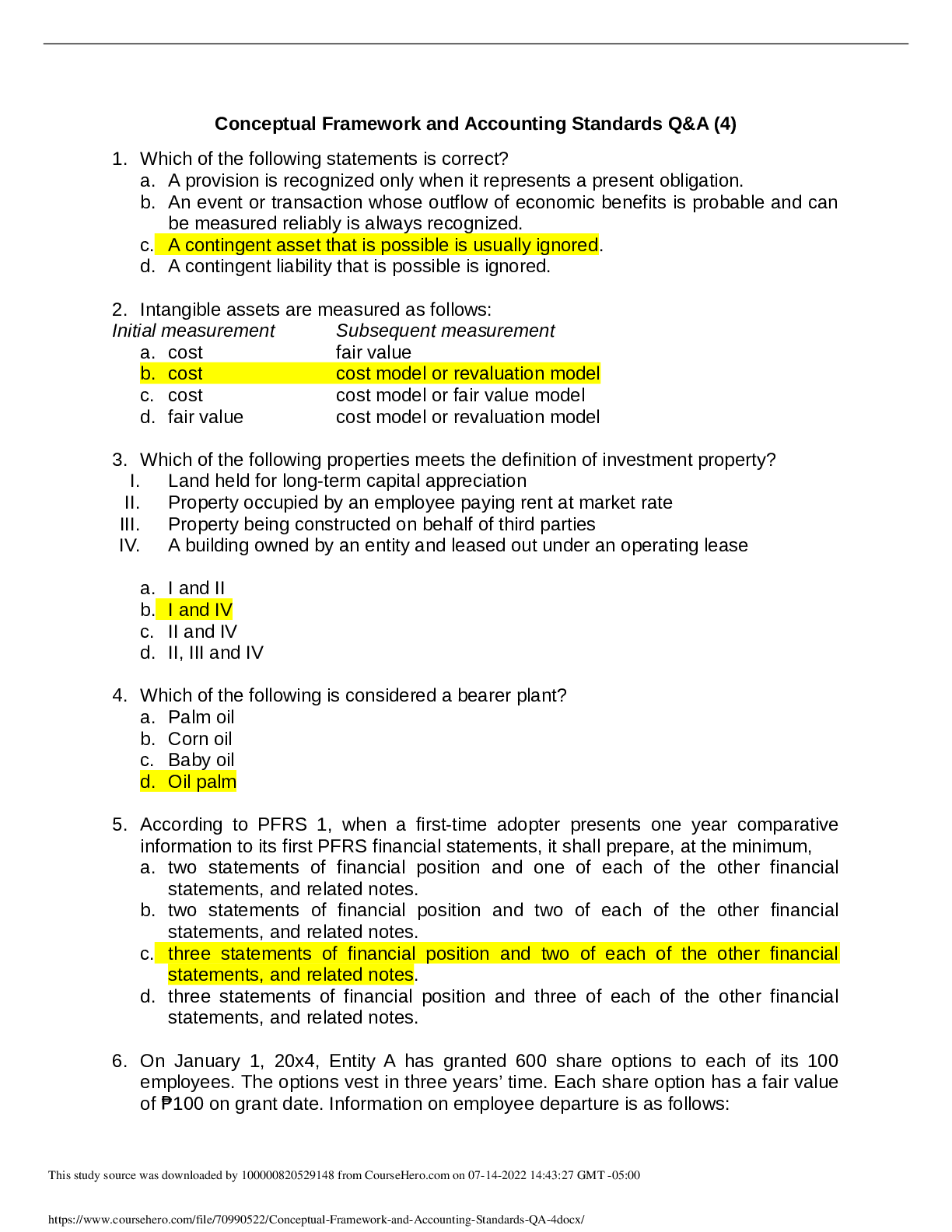
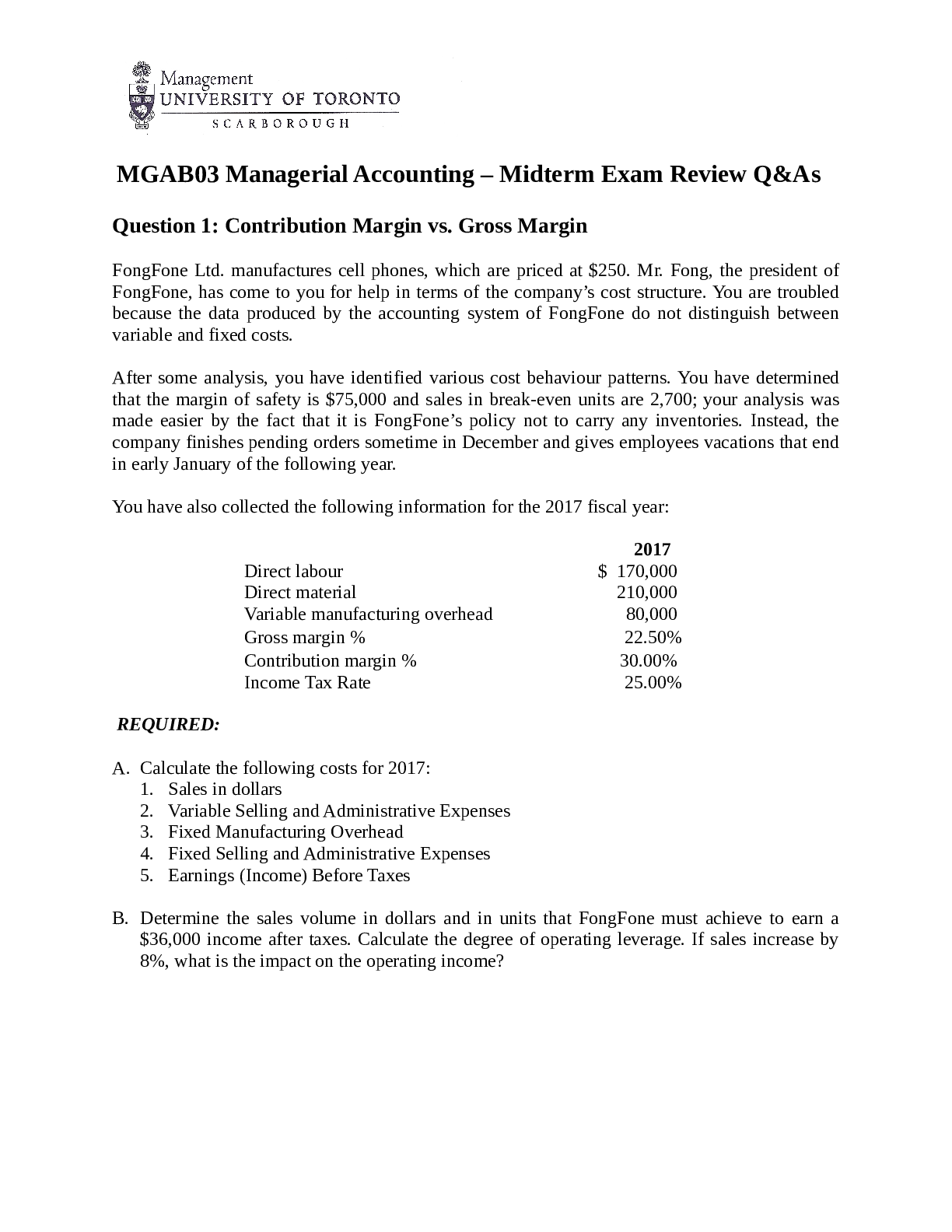
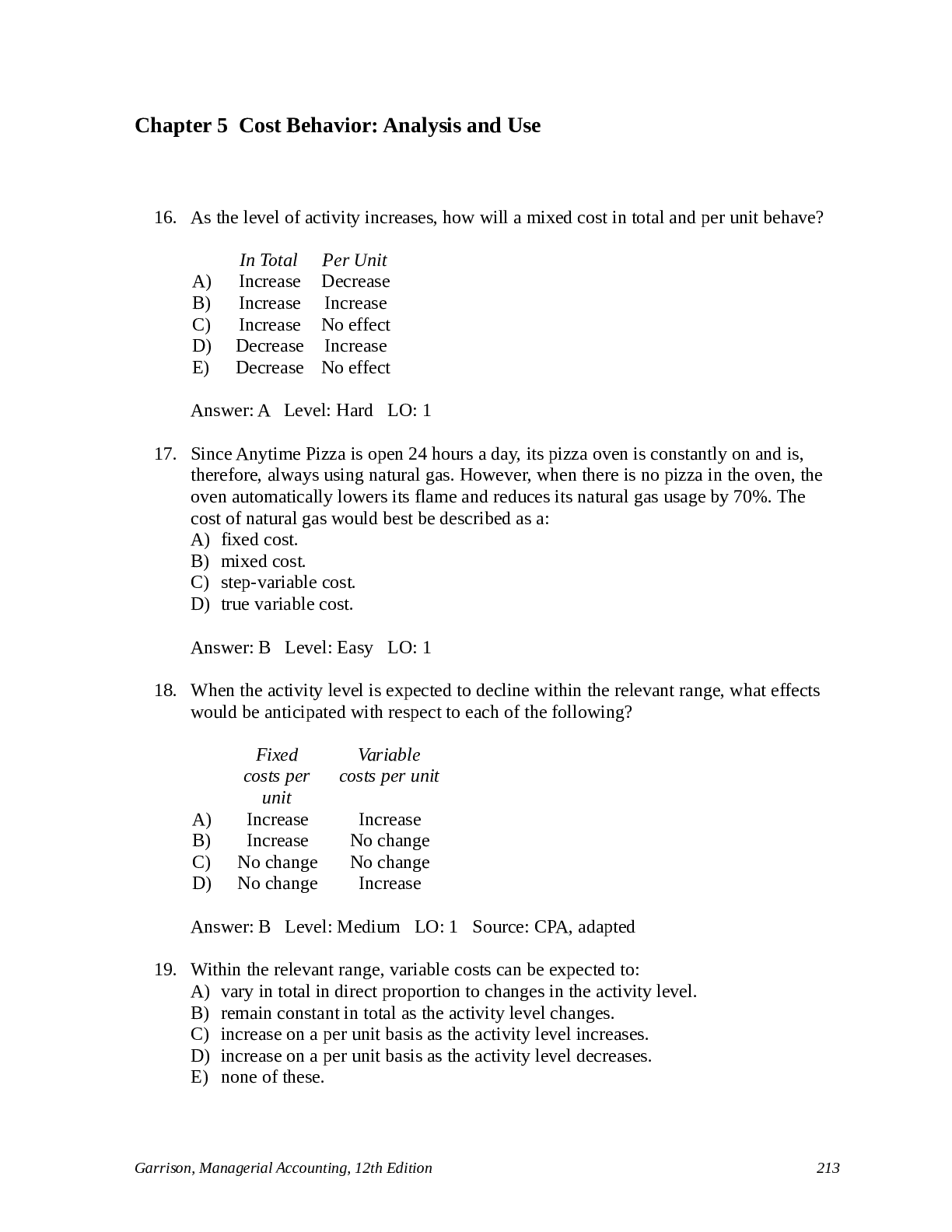
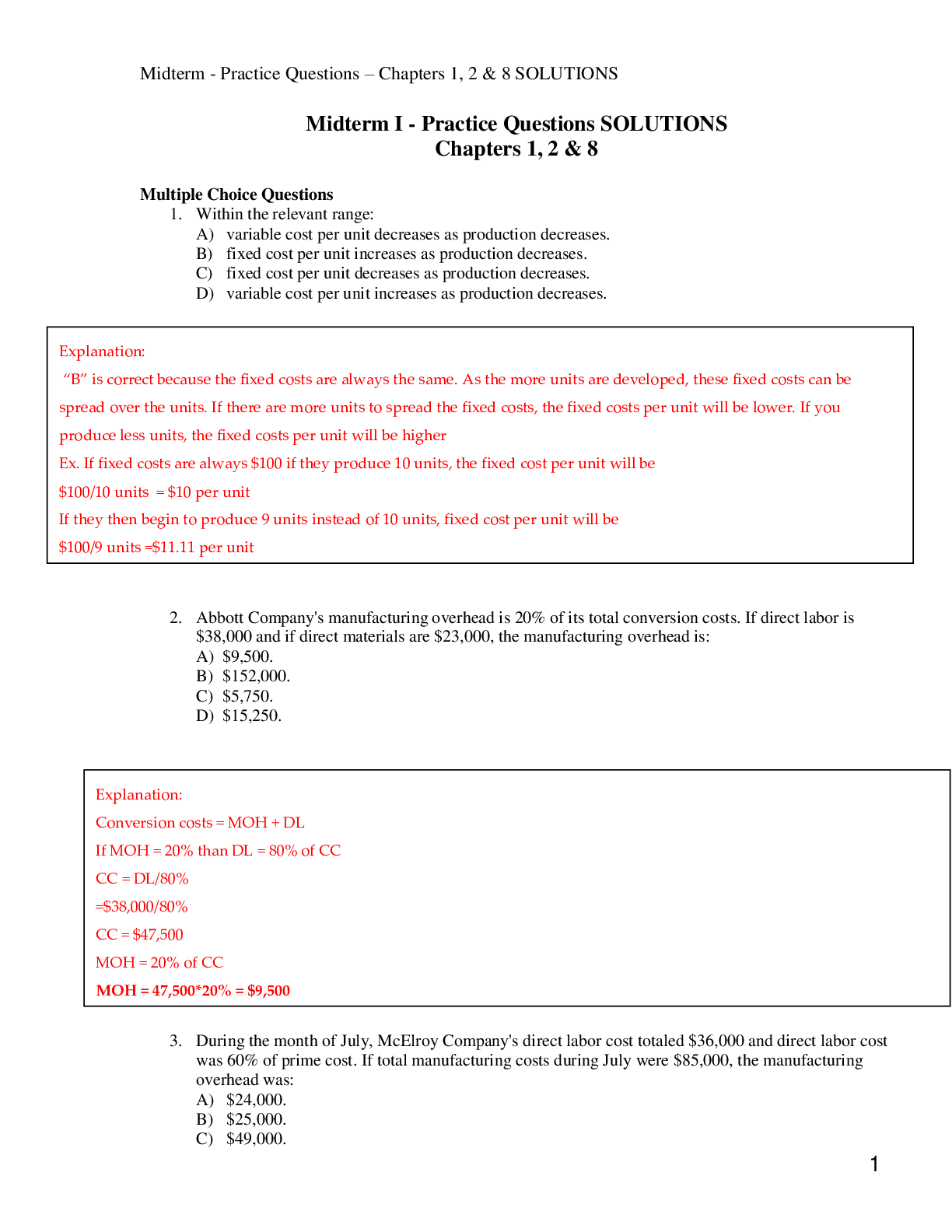
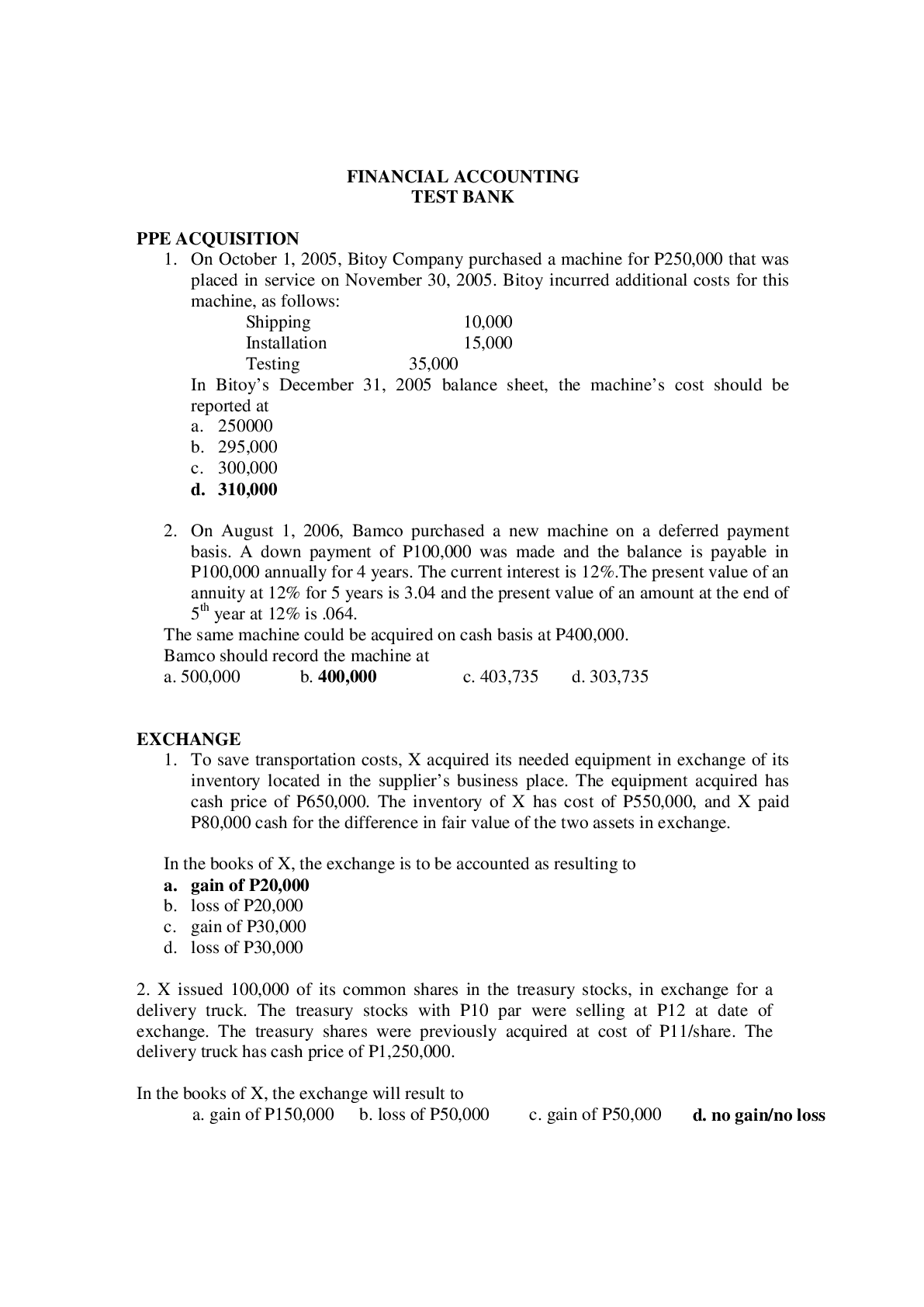

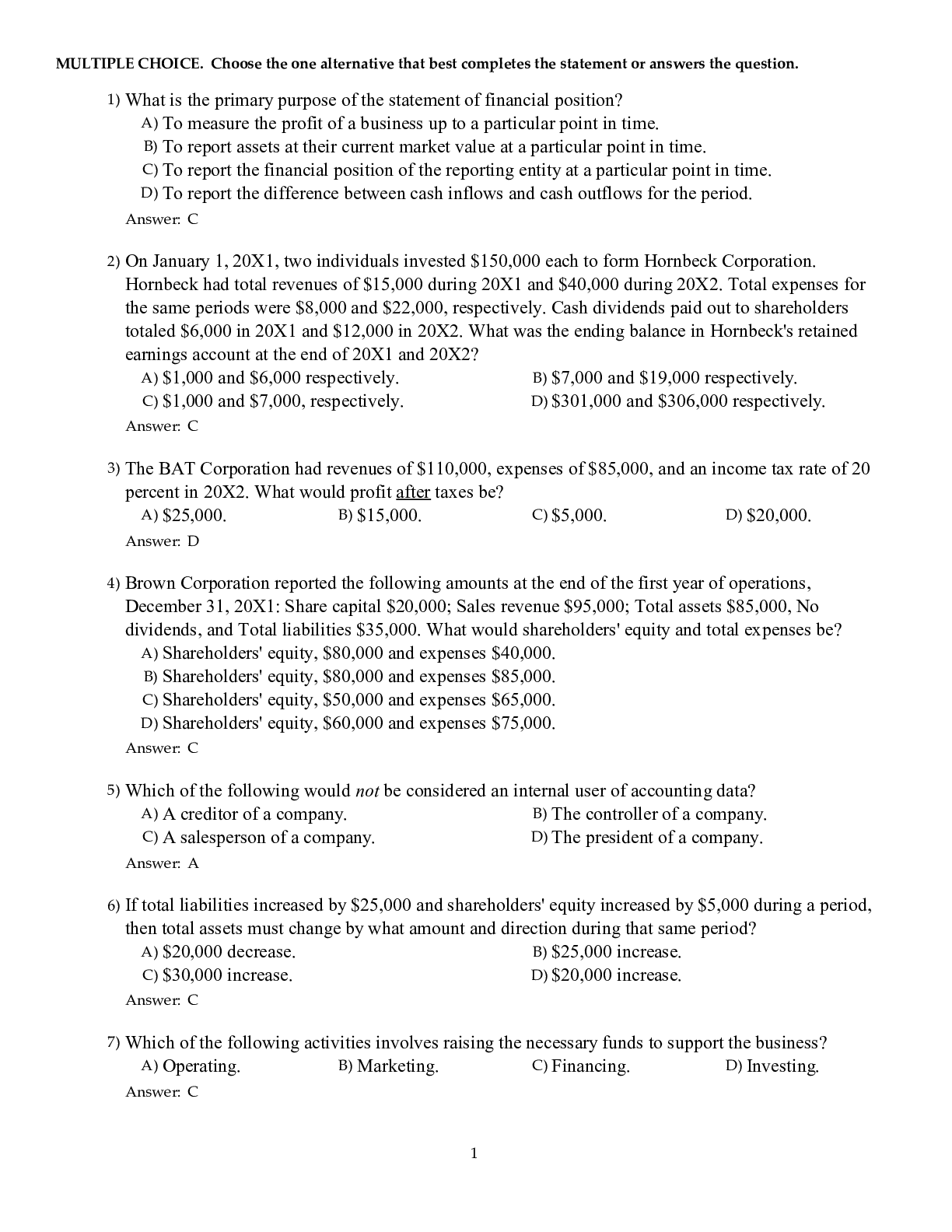

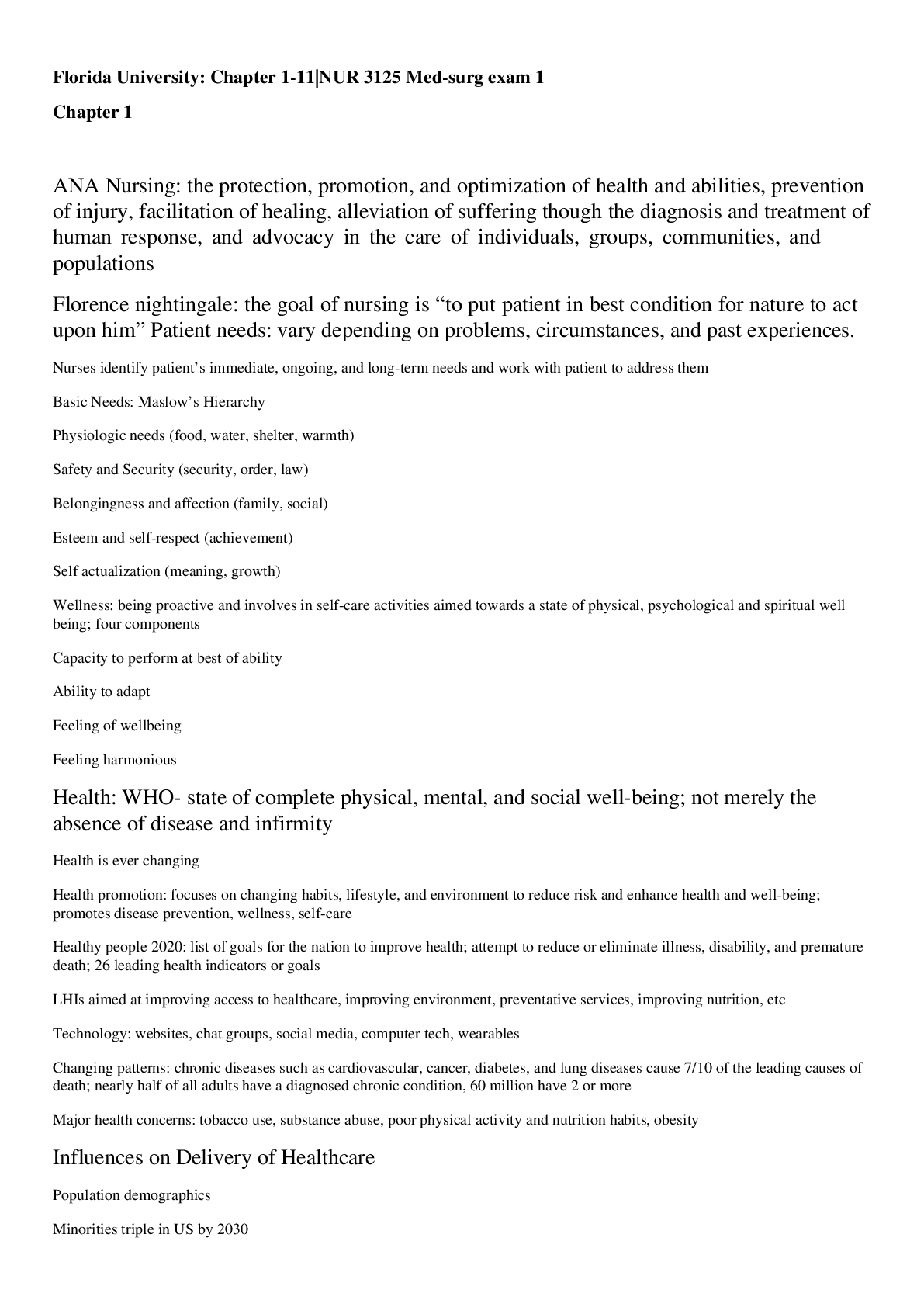
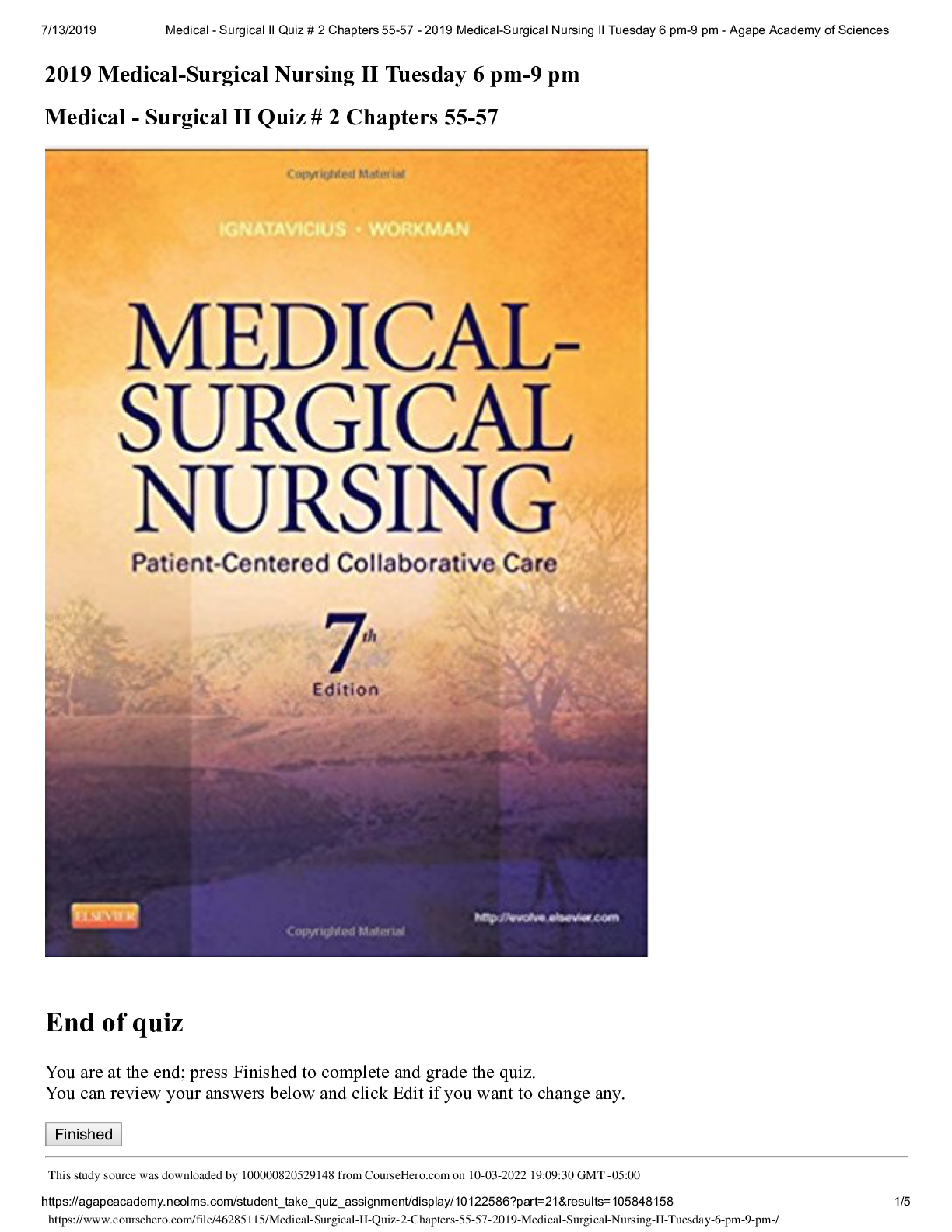
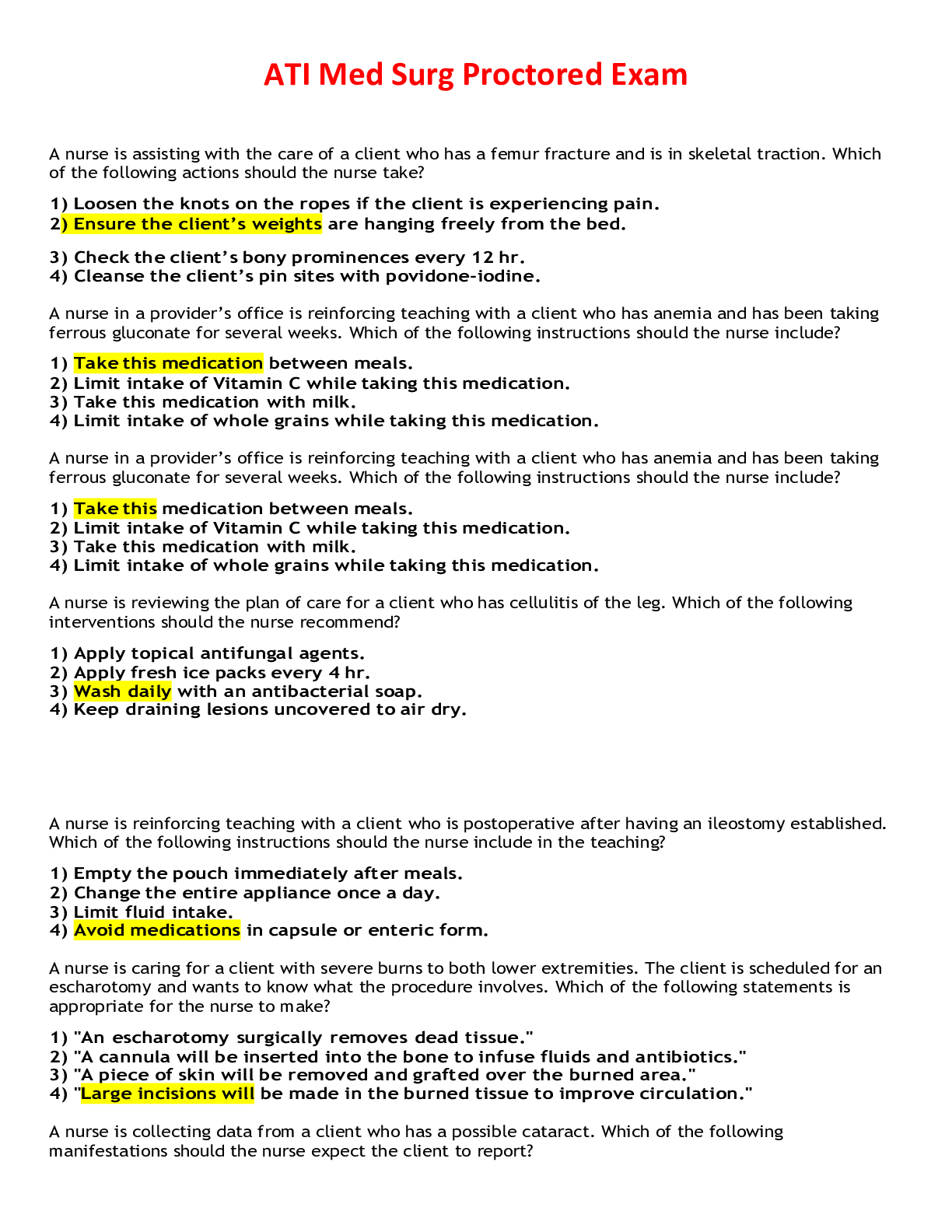
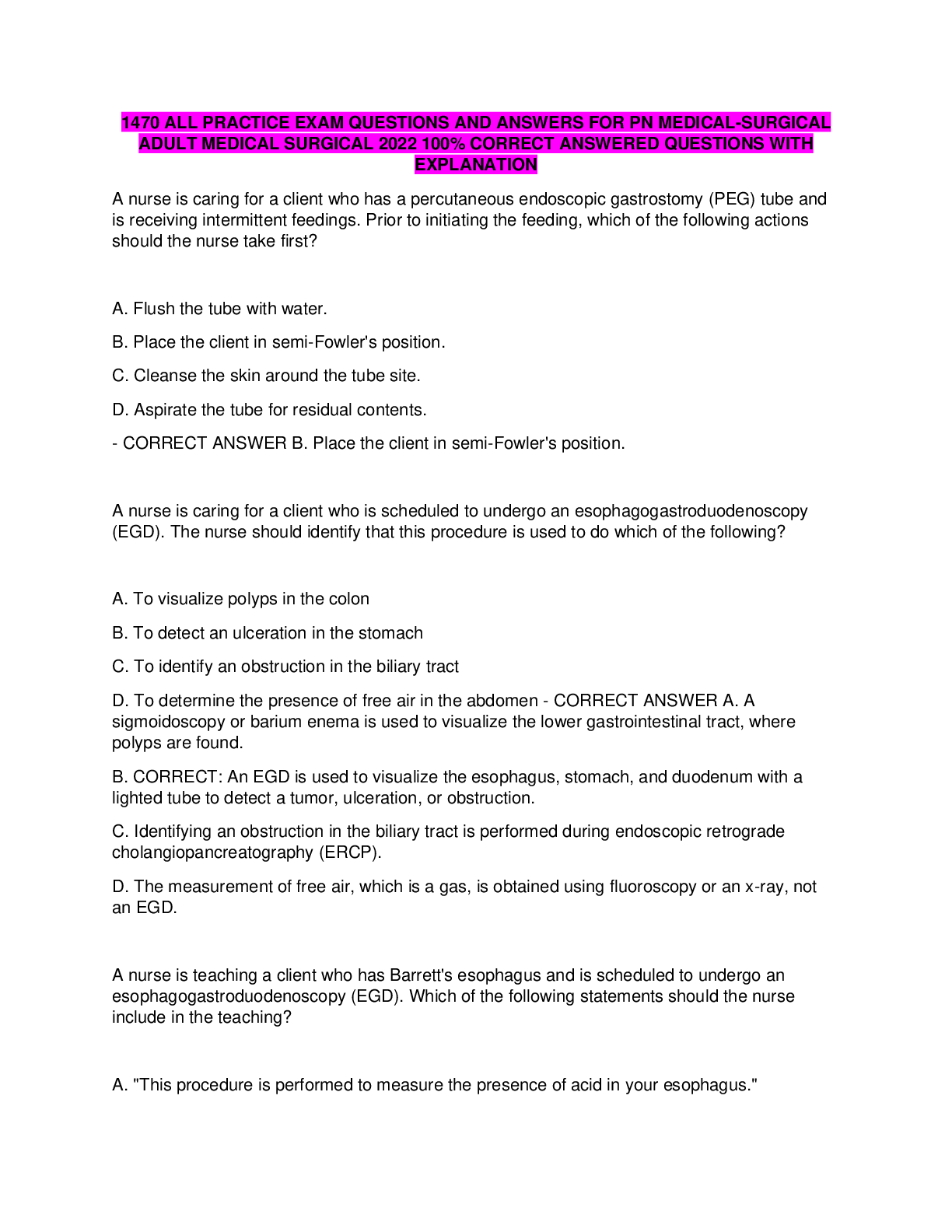

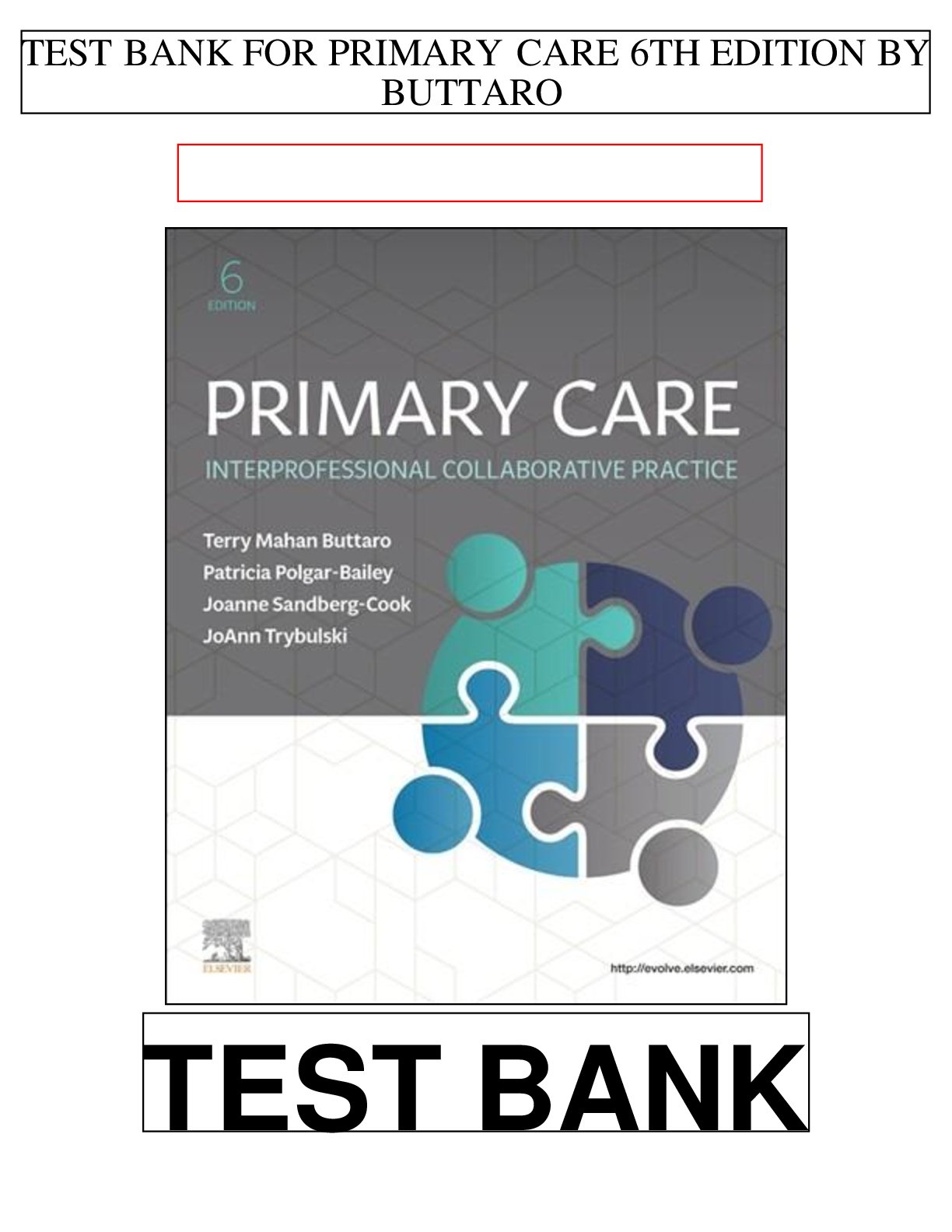
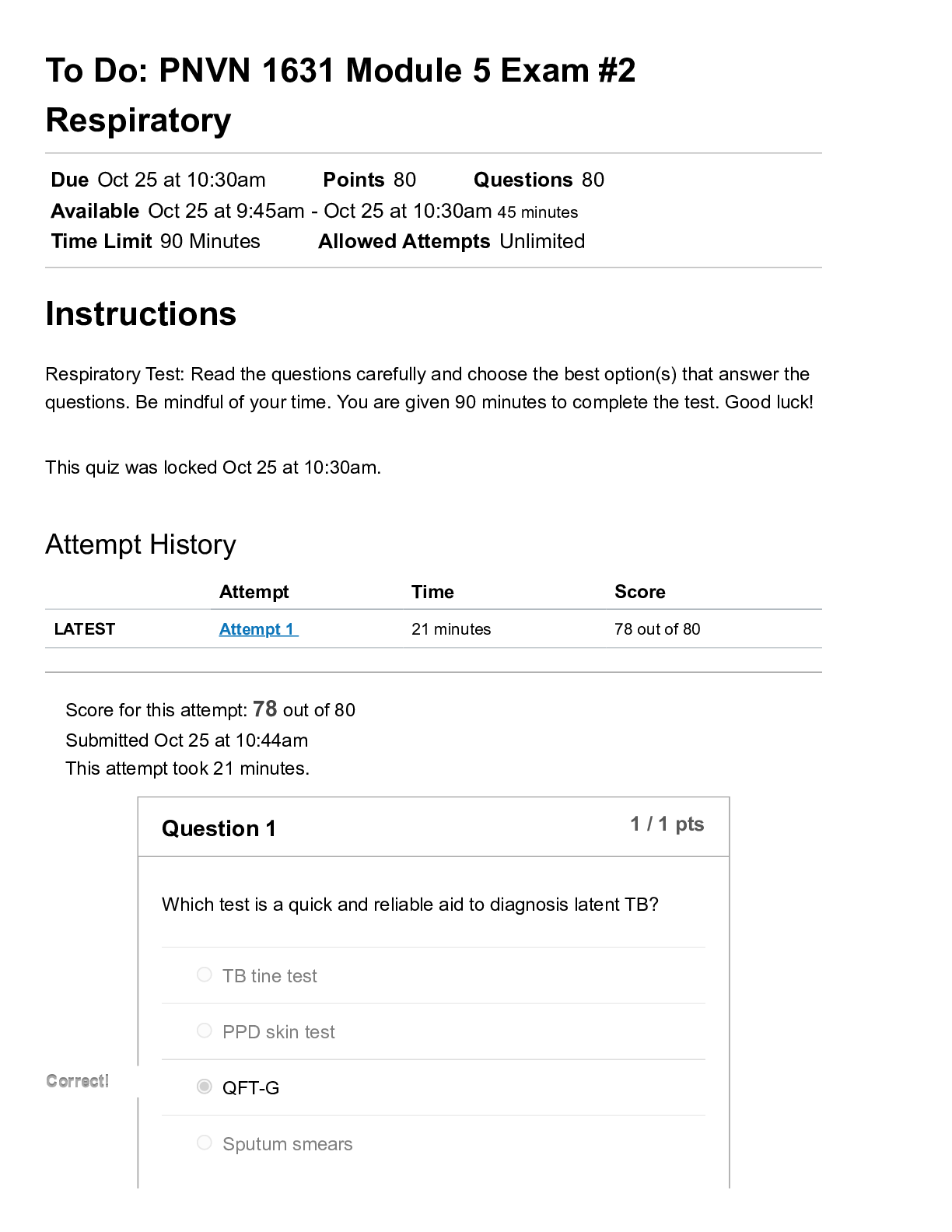
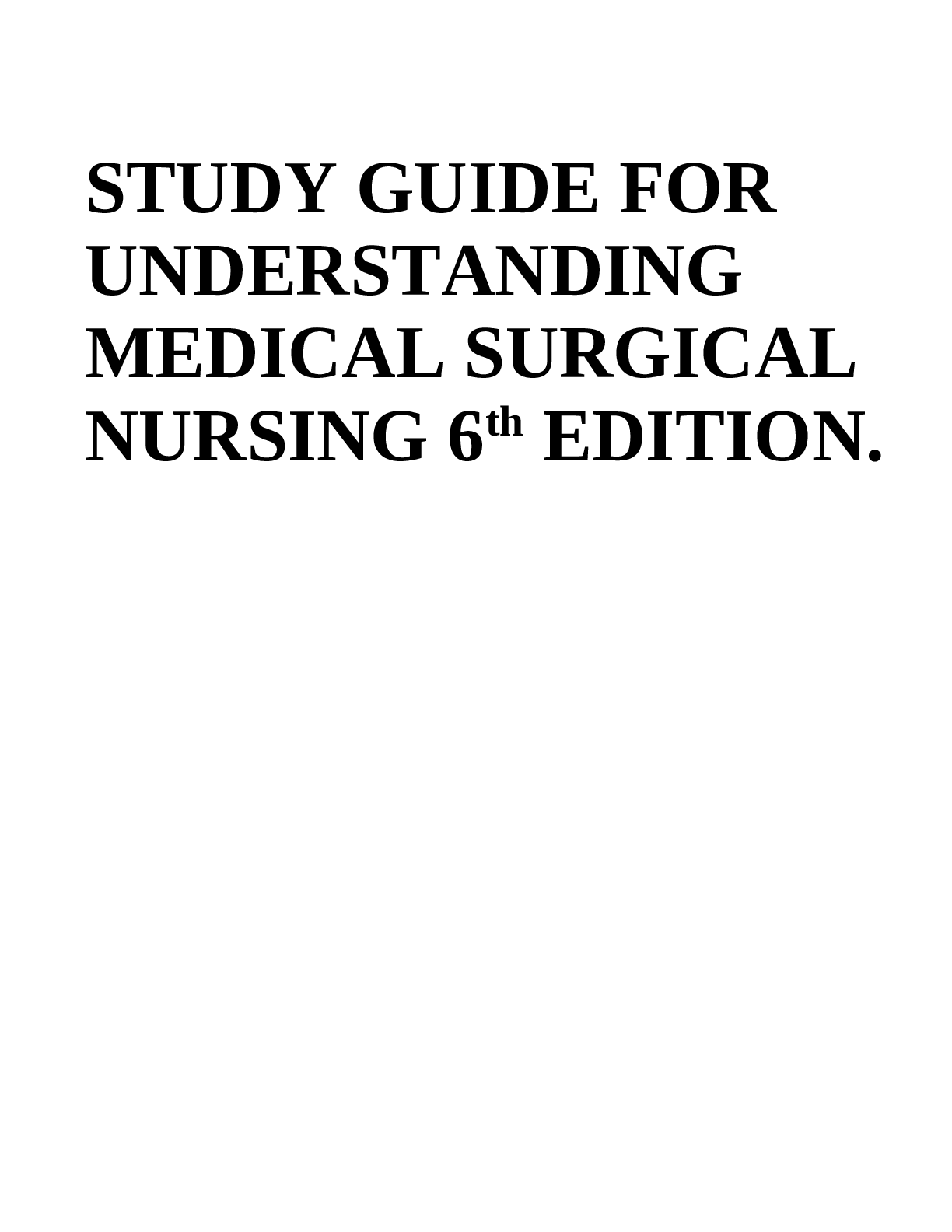
.png)
